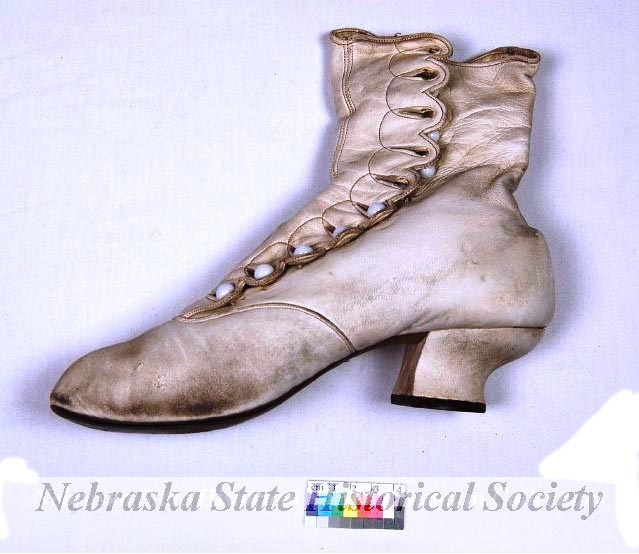Browsing through the advertisements in early Nebraska newspapers reveals that our grandparents and great-grandparents had a choice of fashionable footwear. “A neat foot in a tidy fitting shoe or boot is the pride of the average man and woman,” said the Omaha Daily Bee on April 22, 1888, “and it goes without saying that they will in nine cases out of ten sacrifice the balance of their attire for the more aesthetic attirement of their feet.”
A Bee reporter, after visits to several Omaha shoe stores and interviews of the employees, noted that a weakness for buying shoes “is more noticeable among the female sex, and the existence of the shoe clerk is made miserable and desperate at times in catering to the whims and vanity of the customer. . . . If a woman with a number four foot comes in and calls for a number three shoe, he must abide by her demands, not betray his emotions but look pleasant while he strives to force the much undersized shoe on the overlarge foot. This is a very difficult task, but practice in time makes perfect, and the clerk finally becomes hardened to the cruelty the buyer inflicts upon herself.”
The reporter asked employees in the stores he visited for statistics on the sizes of shoes asked for by Omaha shoppers. “At the establishment of Charles W. Cook a half dozen clerks were busy fitting shoes on the feet of men and women, and, replacing in boxes numberless pairs that had been tried on and discarded by dissatisfied customers. ‘What are the average size of shoes worn by women?’ was asked of the younger Mr. Cook.
“‘Well,’ was the curt reply, ‘they vary like the weather, and we sell some very large ones and some very small ones. However, as far as my observation goes, the ruling sizes are from 3 l/2 to 4’s, made on different kinds of lasts. Some are longer than others, and others broader. We do sell some 3’s but they are few and far between, and in instances of that kind it may be set down that the purchaser would enjoy greater comfort in a shoe a half or full size larger.’
“‘How is it with the men?’ ‘Men as a rule wear from 7’s to 8’s but we have larger sizes. Nevertheless, the first mentioned numbers take the lead.'”
One clerk at another Omaha shoe store corroborated the prevalence of sizes which seem small to the shoe shoppers of 2012, and added: “Men do not wear as large shoes as is supposed. They will average from seven to eight and a half, but eight is about the nearest.”
As modern Americans grew taller and heavier, the size of their feet kept pace. Visitors to the exhibits in the Nebraska History Museum now marvel at the small boots and shoes that once graced the feet of Nebraskans of an earlier day.

This advertisement for A. D. Morse’s Retail Shoe Store appeared in the Excelsior Family Directory of Omaha, 1890-91 (Omaha: Chase and Eddy).

This woman’s wedding shoe was worn by Lucretia Hey Shoemaker in 1884. NSHS 3975-76-(1-2)



